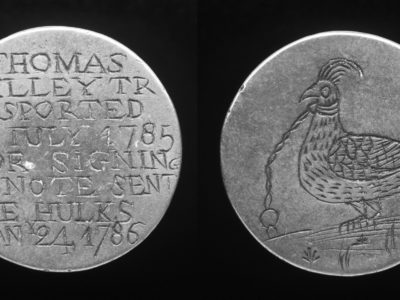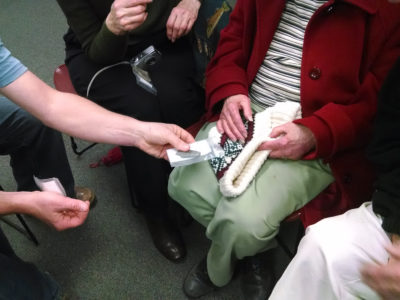
Knowing What We Don’t Know: Challenging the Conventional Narrative in Search of Virginia’s Colonial Plantation Landscapes
 For all that archaeologists and historians have learned from studying plantations in southeastern Virginia, there is a remarkable amount we still do not know. Much of this gap exists under the guise of things we think we know. Have any of us seen the archaeological footprint of a 17th-century tobacco press, corn-crib or stable? What about a dock or warehouse? Do we know where and how these buildings were built, how they “fit” within the plantation’s landscape? If we accept that plantations essentially operated as small towns, complete with systems of roads, quarters, agricultural buildings, fields, docks, and manor houses, and often complemented with mills, manufacturing enterprises, and formal gardens, how do we explain why a region so densely populated with historical archaeologists and so inherently connected with the history of colonial America has made so little progress in understanding the majority of this landscape?
For all that archaeologists and historians have learned from studying plantations in southeastern Virginia, there is a remarkable amount we still do not know. Much of this gap exists under the guise of things we think we know. Have any of us seen the archaeological footprint of a 17th-century tobacco press, corn-crib or stable? What about a dock or warehouse? Do we know where and how these buildings were built, how they “fit” within the plantation’s landscape? If we accept that plantations essentially operated as small towns, complete with systems of roads, quarters, agricultural buildings, fields, docks, and manor houses, and often complemented with mills, manufacturing enterprises, and formal gardens, how do we explain why a region so densely populated with historical archaeologists and so inherently connected with the history of colonial America has made so little progress in understanding the majority of this landscape?
In 2000, we started the Fairfield Foundation, a not-for-profit dedicated to archaeological research and public outreach at Fairfield Plantation in Gloucester County on Virginia’s Middle Peninsula. Our first priority was a shovel test pit (STP) survey of nearly 60 acres of agricultural fields and forest surrounding the manor house ruins and adjacent Carters Creek, a tributary of the York River. The goal of the survey wasn’t to confront inadequacies in the study of plantation landscapes; we simply thought it was the best way to begin understanding this historic plantation that we knew nothing about. Over the subsequent 10 years of extensive sampling and focused excavations on the manor house, nearby quarters, and the spaces in between, these 1,500+ STPs remain the basis for interpreting this complex and constantly changing landscape, challenging us to rethink how we study plantations and their inhabitants. Shovel testing is not glamorous, but it is a quick and proven method for large-scale site study, looking more objectively at a landscape without preconceptions of the ‘best’ places to dig. We by no means planned to ignore the ruins of the 1694 manor house (Figure 1), an architectural enigma that had fascinated researchers since the early 20th century; we just assumed that anyone would begin with the large-scale survey if they could. But in searching for comparable, systematic plantation surveys in our region, we realized how rare it was for archaeologists to look beyond the 10 or 20 acres surrounding the manor house.
When archaeologists and historians study these landscapes – particularly how and why they changed over time – most fill in their knowledge gaps with primary documents from later periods projected backwards, with over-used generalizations from rare contemporary documents, and, most often, with assumptions based on little historical or archaeological evidence. These interpretations aren’t necessarily wrong, but they are often based on logical suppositions of how we, in the present, think those in the past would have acted. There is limited evidence to shed light on these under studied elements of the plantation landscape, and, as a whole, scholars have had little interest in researching them. What we have found, though, is that at Fairfield Plantation (and perhaps elsewhere) these elements reveal the physical evidence for one of the most important periods in the region’s history: the transition from tobacco monoculture to mixed grains and the dramatic and contemporary reorganization of space (See Figure 2). Unfortunately, increasing suburbanization and large-scale development are severely limiting future opportunities to look into plantation landscapes and, with some notable exceptions, few archaeologists are stepping up to the challenge.

Figure 2: STP survey at Fairfield Plantation has demonstrated a changing landscape through four phases from the 17th through 19th centuries. (Figure courtesy of Fairfield Foundation).
Despite widespread development, southeastern Virginia maintains the historical association with plantations and agriculture that defined it for much of the last four centuries. This past is marketed as an invaluable asset to the local economy, and promulgated by many interested residents and descendants. Images of plantations across the tidewater are a vital part of the region’s local identity and the face it promotes to the rest of the state and country. We know that a large 18th-century brick building and terraced garden, surrounding agricultural fields, and occasional barn or slave quarter can each give solitary testimony to our region’s storied past, but these are inherently incomplete and misleading images of plantation life. We cannot expect historic house owners, house museums, and budget-constrained localities, dependent on limited tourist revenue and mired within the prevailing paradigms of plantation interpretation, to push a program of intensive study of the development of the region’s historic landscape. But we, as archaeologists, need to do a better job to confront the wide gaps in our knowledge, to look broadly at landscapes and time, to embrace the 19th century and not just the colonial, and to deal with misconceptions, prejudices, and myths harbored by the public about plantation history. It is our responsibility to better explore the development of these landscapes to fill in the gaps that assumptions have bridged for far too long before the continued development of our region leaves us with only relatively small historic islands surrounding the manor houses of dead rich white men and their families.
Don’t get us wrong – we strongly believe that historical archaeologists have contributed significantly to a greater understanding of the development of specific elements of plantations. We’d like to think that a more comprehensive view of the larger plantation acreage, beyond the manor house, the individual quarters, and the formal gardens, has been as much an essential priority for the many archaeology-focused organizations (private and public) in Virginia as it is for researchers of sugar plantations in Barbados, coffee plantations in Jamaica, or even provisioning plantations in New York and Massachusetts. But looking at the body of research in our region, we realized that despite having seen more projects on plantations than perhaps any other part of the world, systematic plantation surveys numbered exactly two: Thomas Jefferson’s Monticello, and his retreat house, Poplar Forest. Various systematic surveys were undertaken in the 1970s and 1980s (Carter’s Grove in James City County and Stratford Hall in Westmoreland County to name two), but these and a handful of others were seldom written up, the data left inaccessible due to time and funding constraints. Other surveys are still trapped in the grey literature, the scope of work and research designs limited by the priorities of clients and the Section 106 process. Some of our most recognizable plantations, including George Washington’s Mount Vernon, are already islands within a sea of development, but still look in the backyards of their neighbors to recover what they can (Pogue 1988; Pecoraro and Cole 2012). Despite recent trends focusing on plantation gardens and the yard areas around domestic spaces, there remains a very real preference by many archaeologists to focus on individual buildings and activity areas associated with abundant material culture and architectural evidence, because these permit a level of detailed interpretation that seems to pay more dividends than digging several hundred STPs or studying difficult to recognize extant landscape features. In a time of limited funding and a growing curation crisis of previously excavated materials, we’d like to think an approach that better serves preservation of cultural landscapes through their holistic (yet less obtrusive) study would appeal to the community of historical archaeologists.
We’re uncertain whether most scholars in our region will expand their gaze beyond the immediate surroundings of a plantation’s remarkable manor homes, nearby ancillary buildings, and quarters, yet we contend that this expansion is absolutely necessary. While these plantation elements are legitimate research foci, and will always provide new information, they did not exist in a vacuum. To know the manor house we must know the quarter; to understand the gardens we must investigate the fields. How can we expect to decipher how warehouses, docks, and barns functioned within the landscape without mapping the roads, fencelines, and field divisions? Do we understand the complicated interplay between plantation and town, or between manor house, court house, and house of worship? Are we satisfied assuming the public, and funding organizations, believe our time is best spent on the search for “cool things” rather than “cool ideas”? Or do we engage with modern residents and descendant communities to add depth and nuance to our research, confront misunderstandings and misrepresentations of the past, and demonstrate the full potential of the discipline to contribute to a better understanding of the past? As recent blog posts on this site have proven, historical archaeologists of other regions have succeeded in these endeavors. The realization that there is much that we do not know, concerning subjects long thought already decided or relatively unimportant, will lead to a broader challenging of the historical narrative and a greater role for historical archaeology in understanding our shared pasts.
Update 2/27/2012
We are encouraged by the response to the blog we posted on February 22nd and are happy to report that, because of this post, we have been contacted regarding additional plantation surveys in our region beyond those we listed. These include the 500-acres surrounding Mount Vernon, the National Park Service’s acreage at George Washington’s Birthplace National Monument, the Lee family plantation at Stratford Hall, and the plantations on Jamestown Island. Many of these are used as internal planning documents, influencing excavation strategies and site development. Others, by necessity, remain out of public access due to concerns over site preservation. This is not to say that the authors are not encouraging of their use in research by those studying and interpreting plantation landscapes, and many would be happy to share this data. Ultimately, increased interest in looking beyond the plantation’s core will lead to the greater exchange of archaeological data in addition to refocusing the priorities of plantation studies. If you know of other plantation surveys, please do not hesitate to share them in the comment field or contact us separately.
References Cited
- Pogue, Dennis J.
- 1988 Archaeology at George Washington’s Mount Vernon 1931 – 1987, Mount Vernon Ladies’ Association Archaeology Department, File Report #1.
- Pecoraro, Luke and Bill Cole
- 2012 Reanalysis of Two Features at the Potomac Overlook Site, 44FX885, Mount Vernon Ladies’ Association Archaeology Department.








For my dissertation research, I am the beneficiary of an enormous survey at Historic St. Mary’s City in Maryland, conducted by HSMC and the Maryland State Highway Association (with the frustrating acronym of “SHA”). This survey was completed in large part to discover the 17th century sites on the museum’s grounds, but it also has given us a wealth of knowledge about the 18th and 19th century occupations, which were plantation sites. The survey data clearly identifies changes in the landscape, particularly in the locations and orientations of the slave quarters, as well as how the landscape changed after Emancipation. This would not have been possible if not for taking the time to engage in a large scale survey, putting off many exciting opportunities for “cool stuff” and instead painting a clear picture of the context that the town and plantation encompassed. Thanks for the post!